How to select oils for each cooking mode?: General Considerations
How Indian domestic cooking with edible oils is different: In the last post, we noted how industry treats edible oils for its product offerings which is different from what we do at home. HoReCa and organized, billed distribution of ready-to-eats understandably have cooking features borrowed from the industry and domestic cooking. They also have some special (and sometimes unscrupulous) tricks, given their compulsions and freedoms. However, it is interesting to note some specialties of Indian cooking with edible oils at home:
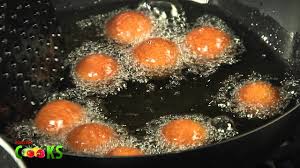
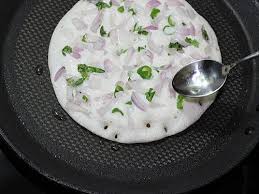


- Despite the recent spread of home-delivery of ready-to-eats, home-cooking is still the preferred mode of creating meals by far. Given the inevitable rise in population (at least in India), home-cooking ‘volumes’ can only increase, offsetting the increases in ordering and eating out.
- Most cooking is for immediate consumption.
- Complete control over all aspects of cooking is an opportunity which the home-maker needs to be empowered to exploit.
- Given the wide preference for unrefined oils in India (regionally, groundnut, mustard/rapeseed, sesame/til and coconut), a lot of cooking happens with them. Price considerations and the need for bland oils for some cooking lead to refined oils. In the West, all cooking (industrial and domestic) is with refined oils.
Hence Indian domestic cooking with oils is a special case that requires original insights.
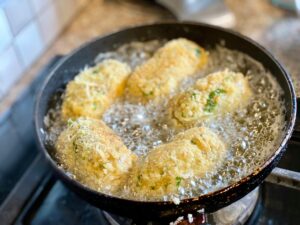
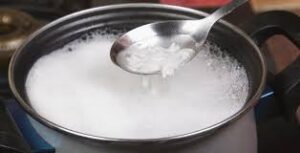
How cooking with water and oil are different: We will eventually devote an entire post on the essential difference between cooking with water and oil – our only two liquid cooking media! For now, since all cooking with water in intrinsically safe from heat damage, the only value-addition can come from not losing nutrients in discarded water and conserving fuel. This can be done by insightfully cooking with ‘just right’ quantities of water and not using the flame at full blast when water evaporation is not a priority but is to be limited for the right finished dish quality. (Important: excess water in savory dishes will pull in excess salt and excess sugar in sweet ones). Essentially, cooking to evaporate water or to concentrate (as in rabdi making) and water mediating in cooking (daily vegetables, rice/khichdi, soups, daals…) are two different things. But these two remain the only modes of cooking with water.
On the other hand, cooking with oils is complicated and varied in modes and oil functionalities. It can also be potentially harmful in case of excessive consumption or flawed cooking. (Ref the following: 1. Post 16: Oxygen, food and life. 2. Post 17: edible oils: An introduction. 3. Post 18: Edible oils have many roles outside our body. 4. Post 19: The physiological functions of edible oils. 5. Post 31: Edible oils – the champion cooking aids, Part I. 6. Post 32: Edible oils – the champion cooking aids, Part II.)
Obviously, then, cooking with oils needs sharper focus.
Functionalities demanded by each mode of cooking: Ref posts 23 and 24 for the description of the modes per se’. Here’s what those modes demand in terms of oil attributes:
-

 Deep and shallow frying: Resistance to oxidation, mainly thru low IV and, preferably, also very low levels of linolenic acid – the most abundant omega 3 fatty acid and the most susceptible to oxidation among mainstream PUFA. This means refined cottonseed, palmolein, groundnut, coconut, mustard, rice bran oils and unrefined groundnut, coconut, mustard oils. (Ref Post 4, Industrial processed foods: Part I, Their evolution and present status and Post 17, Edible oils: An introduction, The multifaceted personality of our cooking oils). Also, resistance to heat-mediated and oxidative polymerization which leads to ‘thickening’ of oil for which compositional requirements are the same. Finally, resistance to hydrolysis i.e. breakdown into glycerol and fatty acids as in intestinal digestion; only coconut oil (and the uncommon palm kernel oil) is measurably vulnerable.
Deep and shallow frying: Resistance to oxidation, mainly thru low IV and, preferably, also very low levels of linolenic acid – the most abundant omega 3 fatty acid and the most susceptible to oxidation among mainstream PUFA. This means refined cottonseed, palmolein, groundnut, coconut, mustard, rice bran oils and unrefined groundnut, coconut, mustard oils. (Ref Post 4, Industrial processed foods: Part I, Their evolution and present status and Post 17, Edible oils: An introduction, The multifaceted personality of our cooking oils). Also, resistance to heat-mediated and oxidative polymerization which leads to ‘thickening’ of oil for which compositional requirements are the same. Finally, resistance to hydrolysis i.e. breakdown into glycerol and fatty acids as in intestinal digestion; only coconut oil (and the uncommon palm kernel oil) is measurably vulnerable. - Thin film (or smear) oil cooking of flats: On the same lines as above but enhanced. Cooking alertness mandated. SS surfaces preferable, copper and even brass are a big no-no. Skill required.
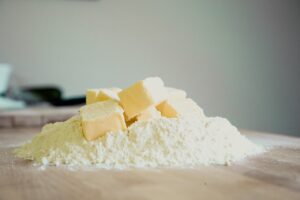 Shortening (moin) for daily roti/paratha: Practically no constraints. High melting fats (ghee, vanaspati, palm oil) must be melted before addition or melted by hand heat while kneading. Limited exposure to heat should present an opportunity to use a high IV (PUFA- rich) oils and once-fried moderate IV oils diluted with fresh oil.
Shortening (moin) for daily roti/paratha: Practically no constraints. High melting fats (ghee, vanaspati, palm oil) must be melted before addition or melted by hand heat while kneading. Limited exposure to heat should present an opportunity to use a high IV (PUFA- rich) oils and once-fried moderate IV oils diluted with fresh oil.- Oil/fat-assisted roasting: The thin filming of the oil around flour particles exposes a lot of area, hence same as in sr. no.2.
- Accompaniments to ready-to-eat dishes: Cold use is an opportunity to use high IV oils.
- Salad dressings: Opportunity to use high IV oils. No restrictions.
-
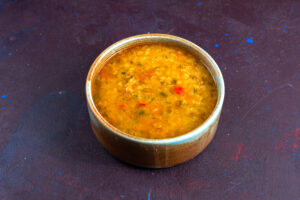
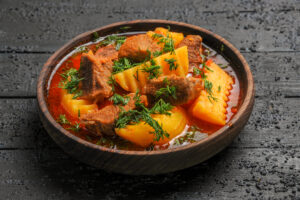 Daily subji and daal dishes: If whole seeds like mustard and cumin are to be ‘crackled’, same as in sr. no. 1. Watch the oil temperature carefully, add dry spices smartly at high temperature with reduced flame, quickly ‘quench’ the jhonk with watery inputs like green chillies, garlic, ginger, tomatoes or even water. Care to be exercised with refined soybean oil, linolenic-rich refined canola oil, refined mustard oil. If using ghee, it is smart to use a small quantity of non-ghee sturdy refined oil for crackling whole spices and then add ghee to retain the ghee flavor carry through.
Daily subji and daal dishes: If whole seeds like mustard and cumin are to be ‘crackled’, same as in sr. no. 1. Watch the oil temperature carefully, add dry spices smartly at high temperature with reduced flame, quickly ‘quench’ the jhonk with watery inputs like green chillies, garlic, ginger, tomatoes or even water. Care to be exercised with refined soybean oil, linolenic-rich refined canola oil, refined mustard oil. If using ghee, it is smart to use a small quantity of non-ghee sturdy refined oil for crackling whole spices and then add ghee to retain the ghee flavor carry through. - Yearly pickles: Despite absence of heating, the duration of storage mandates a naturally anti-oxidant-rich, low IV oil; the conventional preference for unrefined oils generally takes care of this. Opaque jars and cold, dark storage recommended.
The next obvious step is to check out how mainstream cooking oils fare in fulfilling these requirements.
A review of the cooking attributes of available oils:
1.The tendency of frying oils to be taken up by the food being fried depends mainly on what is being fried and how; there is only nominal difference across oils for a given food as long as frying is smart.
- Another parameter unnecessarily complicating the oil selection is the ‘smoke point’; we take the stand that frying temperature will always be maintained well below smoke point of most oils.
- Phosphatides present in unrefined oils (which refining removes completely) tend to promote extra oil take-up during frying of watery batters and aid hydrolysis of oils – both because of their ability to bring oil and water close. However, the regional preference for these oils are strong and other benefits of using them are attractive. Smart frying is expected to minimize both.
- The unrefined version of any oil will always carry more color and flavor/odor, more free fatty acids and more anti-oxidants and vitamins than its refined version. While color of the oil is practically immaterial, its inherent flavor is a preferred attribute in some oils. With extra oil take-up and hydrolysis practically negligible, the advantages of unrefined oils outweigh the disadvantages.
- In any case, consumption of fried foods must always be watched to stay within nutritionally recommended quantity and quality limits.
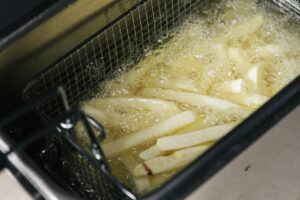 Why an oxidatively sturdy oil must always be available: Most of the cooking that uses both heat and oils would benefit from resistance of the oil to oxidation – mainly low IV (presence of natural antioxidants, preferred) and practical absence of omega 3 fatty acids. This may look redundant in case of dishes for immediate consumption, especially those which show no outward signs that can be sensed. In any case, such immediately detectable damage is possible only if the oil selection and cooking per se’ were totally reckless. Thus absence of detectable rancidity or oxidative off flavors, is not an indication of their absence. Also, baked/fried dishes for the jar are common in Indian kitchens and hence oxidative keeping quality is always welcome. Prefer opaque jars or, at least darkness, for storage.
Why an oxidatively sturdy oil must always be available: Most of the cooking that uses both heat and oils would benefit from resistance of the oil to oxidation – mainly low IV (presence of natural antioxidants, preferred) and practical absence of omega 3 fatty acids. This may look redundant in case of dishes for immediate consumption, especially those which show no outward signs that can be sensed. In any case, such immediately detectable damage is possible only if the oil selection and cooking per se’ were totally reckless. Thus absence of detectable rancidity or oxidative off flavors, is not an indication of their absence. Also, baked/fried dishes for the jar are common in Indian kitchens and hence oxidative keeping quality is always welcome. Prefer opaque jars or, at least darkness, for storage.
We have already seen that edible oils that have initiated but not complete oxidization at the double bonds (PUFA, mainly) are potential health hazards. (Ref post 16, Oxygen, food and life, Part II, The dark side of oxygen). They are ‘deceptively safe’ because they can still make unreasonable demands on the blood and tissue anti-oxidant levels. This can cause pretty deep damage if consumption of such food is frequent and large per episode. A home maker would, therefore, be smart in simply insisting on having one oxidatively sturdy oil in her kitchen.
Always insisting on a perfect oil-cooking mode match is impractical: In post no. 3 (Health, happiness, life and food), we have seen that it is impossible to come up with good food advice for all. This stems from the extreme variety among foods as well as their consumers. Similarly, each cooking mode is unique in terms of demands of oil attributes and available oils are at discrete attribute points; it is not a continuum from which to pick a perfect match. (Ref post 18 on physical functionalities of edible oils and posts 31 and 32 on their versatility as cooking aids). Against this backdrop, a single oil being suitable for all cooking modes is impossible and even a carefully selected oil being ideal for even a given cooking case is difficult. As a corollary, a family would have to maintain stocks of several oils if they were to stick to even generally robust cooking requirements. This is obviously impractical and is further compounded by the following factors:
- Oilseeds and hence oils have seasons and everyone is aware of which oils are available fresh in the unrefined form, when. Hence insistence on a specific unrefined oil for cooking throughout the year would require bulk-buying during season and storage of estimated yearly requirement. Before the flood of quality refined oils a couple of decades ago, this was the practice in most Indian households. Gujarati’s stocked up on unrefined groundnut – their all-purpose oil – by tins in winter.
- Given the humungous imports, refined palmolein, soybean oil, palm oil and sunflower oil are available throughout the year pretty much everywhere but each oil has its own specific applicability.
- Price is always a factor; imported refined canola oil may be an excellent omega 3 oil but its price would be prohibitive for most. Ditto extra virgin olive oil as a great MUFA source with natural oxidation resistance.
- There are always favorites; a Gujarati cannot be forced to love unrefined coconut oil for cooking; he loves his groundnut oil. A Bihari, Bengali, Odia or Punjabi cannot be weaned away from mustard oil (pungent or standard), especially for cooking fish.
- Refined soybean oil, pure gold in most respects, has a bad reputation because of supposedly ‘fishy’ smell which seems to get exaggerated during high temperature cooking.
- In the current times of ‘organized, mass scale retail’, buying all kinds of oils from available basket throughout the year should be relatively easy. In reality, however, all oils are not available uniformly and keeping 3 to 4 types of oils on kitchen shelves is not convenient.
A simple and practical guide to selecting oils for cooking: The previous posts have already primed us on how cooking happens in each case and what role oil plays in it. A slightly different perspective is required in selecting oils for specific cooking modes:
Step 1: Understanding what each mode of cooking demands from the oil i.e. expected functionality of oil.
Step 2: Which oils can fulfill those criteria.
Step 3: Making the actual selection balancing cooking requirements against price and availability.
Step 4: Optimizing to arrive at 2 oils which will cover most cooking satisfactorily rather than perfectly.
Next Post
Selecting specific oils for specific cooking
And how best to do it practically
Visit Disclaimer.
3 thoughts on “How to select oils for each cooking mode?: General Considerations”
Respected Sir,
Greetings from Manorama !!
Request to share your e-mail id to start Introduction communication with your Esteemed Organization. My e-mail id is rita@manoramagroup.co.in
Regards
Rita Ray Chaudhuri
(M) +91 94242 03553
Madam,
We are not an organization yet. You can know about the people behind this blog here: https://letfoodliftlife.com/about-us/.
You can reach us at healthfoods2023@gmail.com or, tstrivedi@gmail.com.
Regards.
Team Let Food Lift Life
Very interesting topic, thanks for putting up.